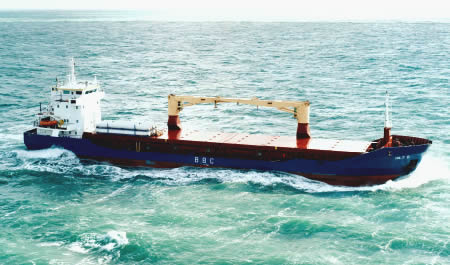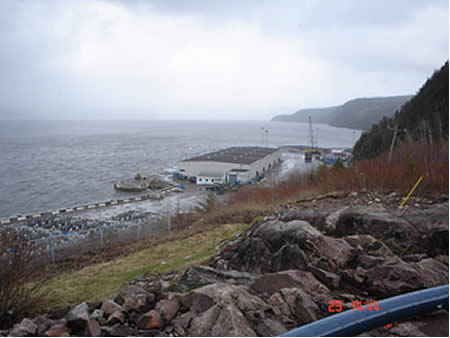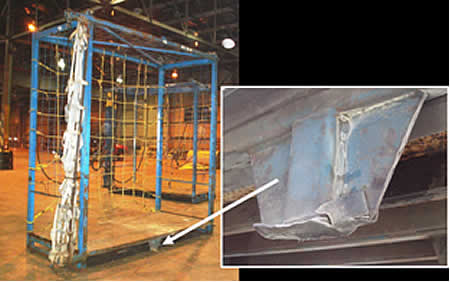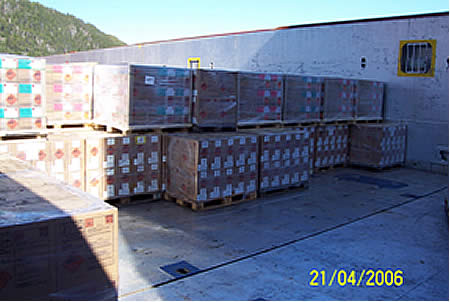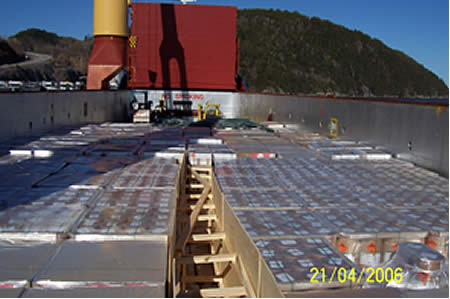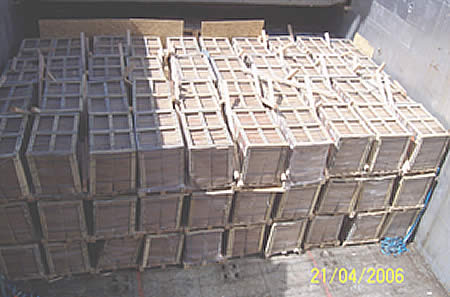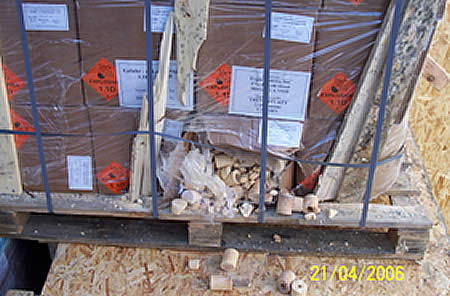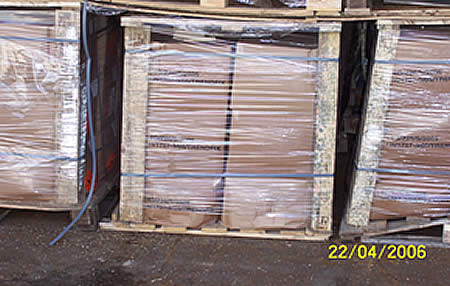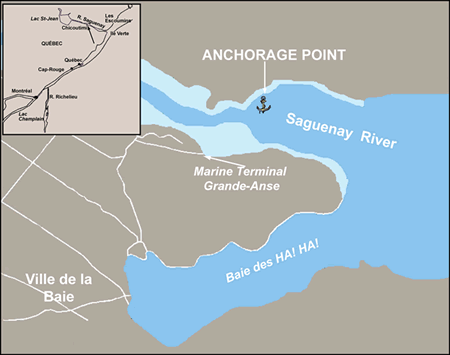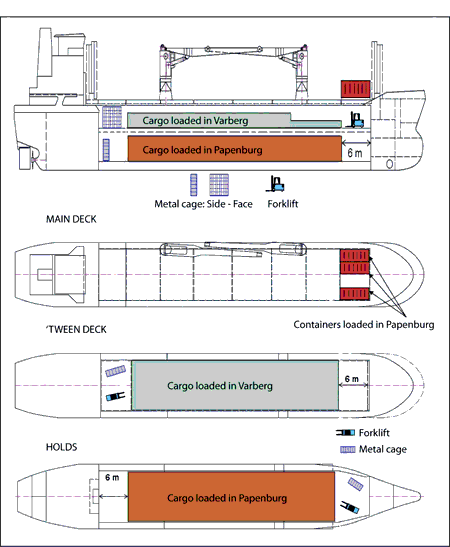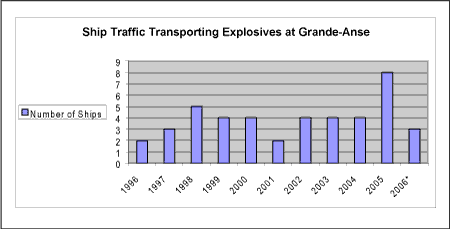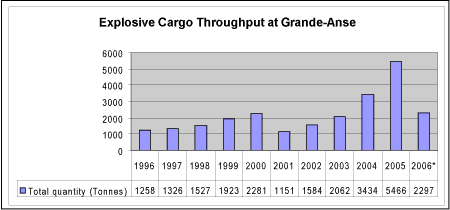Explosion
General cargo vessel Nils B
Grande-Anse Terminal,
Port Saguenay, Quebec
The Transportation Safety Board of Canada (TSB) investigated this occurrence for the purpose of advancing transportation safety. It is not the function of the Board to assign fault or determine civil or criminal liability. This report is not created for use in the context of legal, disciplinary or other proceedings. See Ownership and use of content. Masculine pronouns and position titles may be used to signify all genders to comply with the Canadian Transportation Accident Investigation and Safety Board Act (S.C. 1989, c. 3).
Summary
On 22 April 2006, the general cargo vessel Nils B was unloading a cargo of explosive goods at the Grande-Anse Terminal, Port Saguenay, Quebec, when a small explosion occurred in the lower hold. Two nearby stevedores were taken to the hospital for consultation and then released. There was no damage to the vessel.
Factual information
| Name | NILS B |
|---|---|
| IMOFootnote 1 number | 9194842 |
| Port of registry | St. John's |
| Flag | Antigua & Barbuda |
| Type | General cargo |
| Gross tonnage | 2528 |
| LengthFootnote 2 | 86.4 m |
| Built | 1998, Slovenske Lodenice A.S., Slovakia |
| Propulsion | Alpha, MAN B&W Diesel A/S, 1715 kW, driving a single controllable-pitch propeller |
| Cargo | 1086.4 tonnes of explosives (including packaging) |
| Crew | 8 |
| Registered owner | Bockstiegel Reederei GmbH & Co. KG, Germany |
| Operator | BBC Chartering & Logistic, Leer, Germany |
Description of the vessel
The Nils B is a single-deck general cargo vessel capable of loading containers and dry bulk cargo (see Photo 1). The propulsion machinery and accommodation are located aft.
The vessel, which is strengthened for heavy cargo, has a single cargo hold of 4660 m³ grain capacity. The hold is equipped with removable deck panels that serve as a 'tween deck. The vessel also has a pair of 35-tonne cranes on the port side.
Grande-Anse Terminal
The Saguenay Port Authority (Port Saguenay) managesFootnote 3 the Grande-Anse Terminal and the cargo handling operation services are provided by Quebec Port Terminals Inc. (stevedoring company).
Located between a mountain and the waterfront (see Photo 2 and Appendix A), the terminal, which is dedicated to the reception and shipment of general cargo, is isolated from urban areas, with the nearest private building being almost 2 km away.
Since 1996, the terminal, which has the largest allowable limits for the in transit storage of explosives in CanadaFootnote 4, has seen a five-fold increase in explosives traffic (see Appendix C).
The port authority's services are managed by a general director, an administration and operations director, and a director of security, environment, and maintenance. Combined, the three directors possess a comprehensive knowledge of port operations and procedures. They do not, however, possess specific and detailed knowledge of the best practices for the carriage and handling of explosives.
History of the voyage
The Nils B was loaded at Papenburg, Germany, and at Varberg, Sweden. Its cargo consisted of 24 different kinds of explosive goodsFootnote 5 for a total of 1086.4 tonnes - representing a net explosive quantity (NEQ)Footnote 6 of 962 tonnes destined for Canada and the United States.
The vessel arrived at the Grande-Anse Terminal, Port Saguenay, at 0550 on 21 April 2006.Footnote 7 At 0630, a marine safety inspector from Transport Canada (TC) boarded the vessel to verify its documentation pertaining to the carriage of dangerous goods and to ensure that the onboard fire equipment was ready in case of emergency.Footnote 8 The TC inspector also verified the fire equipment on the wharf. At around 1030, after checking the unloading operation and the condition of the cargo on the 'tween deck, the TC inspector left the terminal.
The vessel was unloaded by two teams of stevedores, with each team comprised of two forklift drivers, a crane operator, and two cargo handlers. Other persons also working in the vessel's vicinity included: two stevedore superintendents, a stevedore manager, and representatives from the charterer and the port authority.
In addition to a watchkeeper at the gangway, other crew members performed maintenance duties or were resting. None of the vessel's crew members were assigned to supervise the cargo operation.Footnote 9
Having received confirmation from the TC inspector that the documents and the safety equipment were in compliance, the port authority representative authorized the unloading of the ship. The cargo operation began at 0800, with the unloading of three containers from the forward part of the cargo hatch covers (see Appendix B for cargo plan). By 0845, the cargo hatch covers were opened and a team of stevedores at each end of the 'tween deck began the unloading. At 1315, forward and aft 'tween deck covers were removed so that unloading could continue from the lower hold. Operations stopped at 2100.
Operations resumed at 0800 the next day, April 22. At approximately 1145, a metal cage was being lowered by the forward crane into the forward section of the hold. When it made contact with the tank top, an explosion took place.
The blast displaced the cage approximately 30 cm upward and deformed one of the support feet (see Photo 3). In addition to the loud noise, shockwave, and smoke, there was a fireball nearly 1 m in diameter. A small fire on the deck was rapidly extinguished by a stevedore using a fire extinguisher.
The explosion took place approximately 1 m from a stevedore who was guiding the metal cage, 2 m from a forklift and driver carrying a pallet waiting for the metal cage, and approximately 4 m from 20 pallets of explosives that had yet to be unloaded.
Emergency response
Upon hearing the explosion and seeing smoke from the hold, the port authority representative (who was in his office, some 400 m from the vessel), as well as three stevedores on the wharf, the chief officer, and the charterer's representative rushed to the scene. The stevedores in the hold and the crane operator remained at their stations.
Some of those who arrived on scene carried portable very high frequency (VHF) radiotelephones. No emergency call was made, nor were any alarms sounded or evacuation orders given. As there were no major material damages or serious injuries, it was deemed to be unnecessary to activate the port's emergency plan. The accident was not reported to the local fire department or Canadian Transport Emergency Centre (CANUTEC).Footnote 10
Following the explosion, unloading operations were suspended and a search was begun to determine the explosion's cause. Although having numerous years of experience in the handling of explosives, neither the stevedores' manager nor the port authority representative was an expert, and they relied on the charterer's representative to discover the cause. It was concluded that an unspecified cargo had exploded when the metal cage touched the steel deck. The area was swept and plywood placed on the deck where the cage was being lowered. Unloading resumed 30 minutes later, in the after end of the hold, and was completed around 1230.
Various samples of possible explosive material were collected from the wharf and warehouse, and kept by a representative from Port Saguenay.Footnote 11
Alerting authorities
Nils B
The situation was deemed under control and logged as a small incident by the master. The Canadian Coast Guard's Marine Communications and Traffic Services (MCTS) centre was not informed.
Saguenay Port Authority
The port authority representative reported the occurrence to a Natural Resources Canada, Explosives Regulatory Division (NRCan, ERD) explosives inspector approximately 45 minutes after the explosion.Footnote 12 The inspector deemed it acceptable that plywood had been installed on the deck and the unloading area had been moved to the after end of the hold, and asked for an incident report.
Stevedore company
The stevedores' manager was uncertain how to handle the situation and, at about 1250, he called his company's Occupational Safety and Health (OSH) director located in Trois-Rivières, Quebec, some 300 km away, to report the details of the event.
To comply with regulations, the OSH director requested that the immediate blast area be secured pending an investigation and/or the possible arrival of potentially interested parties such as TC or NRCan, ERD.
At around 1400, it was determined that neither an inspector from NRCan, ERD nor TC would come to the terminal because unloading was complete. The secured area was reopened, and the vessel's cargo hold was subsequently cleaned and readied for the next cargo.
Alert and warning network system
In 2004, to facilitate the task of the alert and warning system (AWS)Footnote 13 officers, instructions regarding the reporting of transportation occurrences were developed by MCTS, Quebec region, in consultation with TC and the TSB. The instruction package includes, among other things, the following:
- the definition of a marine accident, marine incident, and other reportable occurrences;
- a checklist of information that AWS officers are to request from stakeholders; and
- a list of when and how stakeholders should be advised following a reportable marine occurrence.
The instructions stipulate that the TSB, TC, and other stakeholders are to be immediately informed by telephone following any explosion.
At 1310, shortly after being informed of the accident by the stevedores' manager, the OSH director informed the AWS of the accident. Because this was the first time the AWS officer had been confronted with such a situation, he called the TC standby manager, triggering a series of calls between TC, the stevedores' OSH director, and the AWS officer. The TC manager and AWS officer concluded that no file needed to be opened for this occurrence. Other interested stakeholders were therefore not informed.
On the morning of 24 April 2006Footnote 14, the TC standby manager informed the TC inspector, who had first inspected the Nils B upon its arrival at Grande-Anse, of the explosion. That afternoon, at 1614, TC officially notified the AWS. A file was subsequently opened and notification was sent to some 20 different stakeholders, including: the Canadian Coast Guard, CANUTEC, Fisheries and Oceans Canada, Environment Canada, Port Saguenay, TC, and the TSB. Communication with these stakeholders was carried out by fax. The TSB received the notification the next morning - on April 25 - by which time the Nils B had left port.
Injuries
As a precaution, the two stevedores in the vicinity of the explosion were examined by a physician for potential loss of hearing.
Cargo stowage
Explosive material can be sensitive to friction, heat, and impact, and may have substantial destructive potential (see Appendix B).
In this occurrence, the three containers on the forward part of the cargo hatch covers, as well as the cargo in the lower hold, were loaded in Germany. The cargo on the 'tween deck was loaded in Sweden. On both decks, a 6 m space was left void at each end of the hold, between the cargo and bulkheads, to allow manoeuvring room for forklifts.
Loaded to a maximum of two tiers (approximately 2 m high), the cargo from Sweden had been stowed in a compact manner and arrived undamaged: the dunnage and the pallets were solidly set, the deck had no trace of detritus, and the packaging was solid and clean (see Photo 4 and Photo 5).Footnote 15
The cargo in the lower hold, from Germany, was loaded in three tiers and reached a height of approximately 3.5 m.Footnote 16 There were indications that the cargo had shifted in the lower hold (see Photo 6). Also, the wood planking on some pallets was rotten, and some pallets had missing or damaged flooring. The top of the pallets and the top tank were covered with sawdust and detritus, making it difficult to detect any spilled material. Some packaging was found perforated with cargo spilled on the deck, while other packaging was deformed (see Photo 7 and Photo 8).
Cargo operations
Unloading
Because the TSB did not receive notification of the explosion before the Nils B departed the terminal, a visit to the vessel was made in June 2006 when it called at the same port with a similar cargo.
The practices commonly followed at the Grande-Anse Terminal when unloading explosive cargo are described below. These practices are a combination of those prevalent at the time of the occurrence and measures adopted subsequently in May 2006.Footnote 17
The cargo, which is on wooden pallets, is placed into a metal cage with forklifts. The cage and pallets are then lifted clear by a ship's crane and placed on the dock.
A forklift is lowered on both the 'tween deck and in the lower hold at each end once the dunnage is removed. Once there is sufficient manoeuvring space in the hold, two more forklifts are added, accelerating the unloading.
At times, forklifts would damage cardboard boxes, spilling explosive material on deck. Up to April 2006, there were no measures in place to keep decks clear of small pieces of detritus, and only the larger pieces of dunnage would be removed. By June 2006, these practices had been corrected.
The forks of the forklifts would occasionally make metal-to-metal contact with the deck. As well, due to the limited space within the hold and the number of forklifts operating inside, the forklifts would come in close proximity to each other while manoeuvring.
The metal cages are large enough for two pallets to be loaded side by side. To accelerate the operation, four pallets could be stacked two tiers high. Sometimes, the lower tier would be damaged or crushed by the weight of the upper tier.
To facilitate the forklifts' operation and to ensure rapid, uniform, and safe unloading, the metal cage is always lowered in the same area in the hold. To accomplish this manoeuvre while the vessel is rolling - the result of transferring cargo via cranes - the cage is dropped a few centimetres onto the deck. Since the incident, a sheet of plywood has been fitted to the underside of each cage.
Once the pallets are on the wharf, forklifts moved them into the warehouse. Pallets would sometimes fall onto the wharf due to the poor quality of the packaging/pallets and their handling.
All packaging found to be damaged is replaced by new packaging material shipped with the cargo (when available) or by other boxes that are then hand-labelled. Contrary to the International Maritime Dangerous Goods Code (IMDG Code), however, the repacking is routinely done without using salvage packingFootnote 18 and without any packing instructions from the box manufacturer. Otherwise, minor damage is often repaired with tape or by covering the entire pallet with wrapping plastic.Footnote 19 Since May 2006, the cargo is now repacked according to the recommendations and under the supervision of the specialist on scene.
Equipment
The stevedores used metal cages with steel feet, steel hammers and crowbars, standard propane-powered forklifts with steel forks, standard brooms, and dustpans in close proximity to the explosive cargo. Following the May 2006 meeting, new procedures govern the use of this equipment.
Analysis of explosive samples
Regardless of whether the spillage occurred after the product left the manufacturer or during loading operations, it was not reported by the stevedores in Papenburg. Upon its arrival in Grande-Anse, packaging was found damaged. Moreover, explosive material was found on board the Nils B and at other locations in the terminal on 22 April 2006 and again during the TSB visit in June 2006. Laboratory analysis revealed that these samples had the potential to detonate if subjected to impact, friction, or heat.Footnote 20
Regulatory regime for the carriage of dangerous goods
The International Convention for the Safety of Life at Sea (SOLAS) and the International Maritime Dangerous Goods Code (IMDG Code)
The IMDG Code was developed under the auspices of SOLAS as a uniform international code for the transport of dangerous goods by sea between states. It covers such matters as packing, container traffic, and stowage, with particular reference to the segregation of incompatible substances. The code became mandatory on 01 January 2004.
Canada's Dangerous Goods Shipping Regulations
Prior to 07 June 2007, the Dangerous Goods Shipping Regulations issued under the Canada Shipping Act was the regulatory instrument used to implement the IMDG Code in Canada and meet Canada's obligations under SOLAS. TC Marine Safety Directorate is responsible for administering the IMDG Code in Canada.Footnote 21
Inspections by the TC Marine Safety Directorate are not mandatory when dangerous goods are being handled. However, marine safety inspectors visit every foreign vessel that calls at a Canadian port to discharge explosives.Footnote 22
Explosives Act and Regulations
Within Canada, explosives are regulated under the Explosives Act NRCan, ERD administers this act and its regulations. NRCan, ERD inspectors are recognized as the subject matter experts. However, the Explosives Act does not extend to the transportation of explosivesFootnote 23 - this is covered by the Transportation of Dangerous Goods Act, 1992.
Transportation of Dangerous Goods Act, 1992 and Regulations
The Transportation of Dangerous Goods Act, 1992 applies to the handling and transportation of dangerous goods within and between provinces as well as internationally.
Within TC, the Transport Dangerous Goods Directorate works with provincial, territorial, and federal agencies including NRCan, which is responsible for issues concerning explosives and the Canadian Nuclear Safety Commission. In addition, it works with TC's Marine Safety Directorate, which is responsible for administering the Transportation of Dangerous Goods Regulations (TDG Regulations) and the IMDG Code in Canada.
Memoranda of agreement have been signed with each province and territory on matters of regulatory compliance involving the highway movement of dangerous goods. These memorandums enable TC to direct its enforcement efforts towards the transportation of dangerous goods by air, rail, and sea. The regulations are referenced or adopted by all provinces and territories. The Transport Dangerous Goods Directorate is involved in the development of international rules and standards through the United Nations. Its program is harmonized or aligned with international and United Nations recommendations and United States requirements.
The Transport Dangerous Goods Directorate includes CANUTEC, which provides a 24-hour, 7 days per week emergency advisory and regulatory information service.
Interface between the IMDG Code and the TDG Regulations
The TDG Regulations apply to the marine transportation of dangerous goods (other than in bulk) between two places in Canada. Furthermore, the TDG Regulations require that transportation of dangerous goods, between Canada and another country (except an inland voyage) or between two points in Canada on a Home Trade Voyage Class 1, shall comply with the IMDG Code.
In the case of explosives unloaded in Canada by a ship engaged in an international transportation, the IMDG Code applies until the cargo lands on the dock apron, when it becomes subject to Canada's TDG regulatory regime.
Canada's ports
Regulatory regime
Federally owned ports in Canada are regulated by the Canada Marine Act. Most are classified as Canada Port Authorities (CPAs) which are autonomous bodies with their own letters patent. TC has retained direct authority over a limited number of public ports, most of which are in remote locations. Port Saguenay is a CPA and manages the Grande-Anse Terminal.
Regulations issued under the Canada Marine Act include the Port Authorities Operations Regulations for CPAs and the Public Ports and Public Port Facilities Regulations for public ports. These regulations include references to dangerous goods and emergency situations. Some CPAs have issued their own regulations and guidelines that further define procedures and responsibilities with respect to dangerous goods; Port Saguenay has not.
Governance of terminals
Many CPAs own and develop marine terminals. In larger ports, it is normal practice for cargo terminals to be leased out to terminal operators for lengthy periods. The authority (usually described as a "landlord" port) then exercises control through the terms of the lease and any applicable port regulations, by-laws, or guidelines. Other authorities have chosen to be "operating" ports and to manage the terminal themselves. In this latter case, authorities enter into arrangements with ship/cargo interests and employ stevedoring companies to handle the cargo operations.
Port Saguenay is the manager of Grande-Anse Terminal and the cargo handling operation services are provided by Quebec Port Terminals Inc.
Handling explosives in Canadian ports
Larger ports in Canada have developed in-house expertise on the handling of dangerous goods, including explosives cargo.Footnote 24 This allows for effective oversight and ready access to authoritative resources. Smaller ports - such as Port Saguenay - that do not have in-house expertise rely on the proactive involvement of TC Marine Safety and Transport Dangerous Goods directorates, NRCan, ERD, plus the expertise available from the local terminal operator or stevedores, as well as the shipper or receiver of the explosives.
IMO's Recommendations on the Safe Transport of Dangerous Cargoes and Related Activities in Port Areas
The IMO provided a set of recommendations for the handling of dangerous cargoes within port areas through Maritime Safety Committee (MSC) Circular 675, Recommendations on the Safe Transport of Dangerous Cargoes and Related Activities in Port Areas.Footnote 25 These recommendations address issues such as training, stakeholders' shared responsibilities, and the handling of dangerous goods while within the port area. The document includes guidance on handling Class 1 explosives - specifically covering loading, handling, equipment, cleanliness, and fire precautions. The document proposes the naming of responsible persons for various situations and lists selection criteria (See Appendix F).
Assessment of quantity limitations - Distance for explosives
In Canada, the interdepartmental Technical Committee on Dangerous Goods surveys and evaluates the various terminals for their suitability to handle explosives and, if suitable, establishes the quantity of explosives allowable. This process and its results were not incorporated into any regulation at the time of the occurrence; however, the outcome was regarded by the port authorities as binding.Footnote 26
Appendix E presents the results of the evaluation of the Grande-Anse Terminal on 25 June 2003.
Training, certification, and experience
In accordance with the TDG Regulations, the stevedoring company gave training to all staff working with dangerous goods.Footnote 27 The course material included information on the nature of dangerous goods and their safe handling. It also included general information on the precautions to be taken when dealing with dangerous materials and specifically those likely to be encountered at Grande-Anse, such as explosives. Finally, it included information on the importance of establishing and following an emergency plan. In terms of on-the-job experience, most stevedores had over five years of experience handling explosive cargos and some had over 25 years of experience in handling general cargo.
The charterer's representative had nearly 20 years of experience working with explosive cargo. This included being responsible for the logistics of receiving orders from firms in Canada and the United States, collecting the goods in Europe, chartering the vessels, and shipping cargo from ports to consignees.
Both the master and the chief officer held certificates of competency for the service and voyage on which the vessel was engaged. Both had also taken dangerous goods training and were certified accordingly.
On several previous occasions, the crew of the Nils B had transported dangerous goods.
Safety management and emergency planning
Nils B
The Nils B was employed to carry explosives between Europe and Canada under a time charter. The charter party defines the responsibilities of the operator and the charterer. Under this arrangement, the vessel must be presented in good condition and duly certified. This responsibility is not limited to the vessel's operator, but also includes the master and crew, who must ensure the vessel's seaworthiness, proper cargo stowage, and certification compliance. The charterer is responsible for cargo handling at both ends of the voyage. Whether the bills of lading for the cargo were annotated (claused) by the master as to condition on loading is unknown.
The International Safety Management (ISM) Code provides for safe practices in ship operation and a safe working environment, establishes safeguards against all identified risks, and seeks to continuously improve the safety management skills of personnel ashore and aboard ships, including preparing for emergencies.
The ISM documentation of the Nils B, concerning the carriage of dangerous goods, is limited to the following reference:
...Cargo operations are subject to SOLAS Chapter VI. For particular cargoes, the relevant regulations are to be observed (e.g., Dangerous Goods Code, Code of Safe Practice for Solid Bulk Cargo)...
The master had no specific instructions concerning explosive cargo; for example, information on tools and equipment to use, handling operations, stowage and securing of goods, and surveillance during the voyage. Emergency schedules that are found in the IMDG Code and which are specific for each dangerous good - and could have guided the master - were on board but not readily available.
On the Nils B, the chief officer is responsible for cargo operations. During the TSB's June 2006 call at Grande-Anse Terminal, he was not always aware of cargo damage and he did not regularly monitor unloading operations. This was left to the stevedores' superintendent and the charterer's representative. The latter divided his time supervising both the vessel's unloading operations and road shipments.
Saguenay Port Authority
The port authority has its own emergency management plan that gives general information about the port and its administration, and identifies the roles and responsibilities of stakeholders (internal, municipal, provincial, federal, and private). The plan includes communication procedures, a telephone directory, an intervention strategy for various emergencies, and required training for different stakeholders.
One aspect of the emergency management plan covers fire or a spillage of explosives. In the event of spillage, the plan states that:
- explosive material is not to be touched or stepped on;
- all possible sources of ignition (cigarettes, sparks, flames) are to be eliminated;
- radios are not to be used within 100 m of any electric detonator;
- CANUTEC is to be called and the situation is to be evaluated for fire, for risk to people and property, required material, and human resources; and
- the fire department is to be alerted, if necessary.
In the event of a cargo fire, the plan states that:
- the area is to be evacuated to a minimum distance of 1600 m;
- any vehicle or cargo that has been exposed to fire is not to be moved; and
- the fire department, CANUTEC, and local residents are to be informed.
The emergency management plan contains no contingency for explosions.
Fire suppression system on the Nils B
The Document of Compliance for the carriage of dangerous goods, which is mandatory, states that the Nils B may, under certain conditions, carry explosives.Footnote 28 One condition is that Class 1 explosives must be stowed within range of the sprinkler system placed under the cargo hatch covers. Stowing any cargo in the lower hold would therefore require that the panels that comprise the 'tween deck remain open throughout the voyage.
In both April and June 2006, it was observed that the removable 'tween deck panels were closed. This would have prevented water from the vessel's sprinkler system from reaching cargo stowed in the lower hold.
'Tween deck hatch covers
After completion of loading the lower hold at Papenburg, the crew installed the four 'tween deck covers so that loading could take place on top of the panels at Varberg. After completion of discharge of the 'tween deck at Port Saguenay, the crew removed these same panels so that cargo in the lower hold could be accessed for discharge. In both instances, these deck covers were being handled directly over explosives that had the potential to explode upon impact.
Analysis
Source of ignition
Samples associated with the Grande-Anse incident were identified as explosives and laboratory analysis concluded that these materials would ignite if subjected to impact, friction, or heat.
Because there was no source of friction or heat in the immediate vicinity, it is likely that the detonation occurred when the metal cage made contact with the explosive material on the tank top.
Practices for the safe handling of Dangerous Goods
Shipboard practices
The master and the chief officer were responsible in theory for making sure the entire operation was safe; however, in practice, they relied on the stevedore and the charterer's representative to load and unload the vessel.
On many occasions, the Nils B, its crew, and the adjacent terminal were placed at risk, as the following examples demonstrate.
- Emergency procedures were not readily available, leaving crew members unprepared for situations such as a spill or fire in the cargo hold.Footnote 29
- The hold was separated into the 'tween deck and the lower hold using removable panels. This prevented the onboard sprinkler system from reaching all cargo. Moreover, by manipulating the heavy pieces of removable deck covers directly above the impact-sensitive cargo, the crew risked a possible explosion.
- The Nils B was not equipped with specialized equipment and cargo gear for handling dangerous goods. Instead, the stevedoring company supplied standard equipment and tools and the master performed no verification of the equipment to ensure that it was spark-proof or intrinsically safe.
The vessel's safety management system documentation contains only a single sentence providing general instructions for the loading of dangerous goods. This gave the master little tangible guidance in ascertaining the best practices for cargo tools and equipment, stowage and securing of dangerous goods, cargo surveillance during the voyage, and cargo operations during loading and unloading.
Stevedore company practices
Unsafe conditions must be recognized before they can be reported by employees, who must then have a functional channel to do so. Individuals who are consistently exposed to a particular situation, however, come to see that situation as normal.Footnote 30 Safety standards may therefore slowly deteriorate, with the result that those unsafe conditions, which would be seen as abnormal or unacceptable to an objective observer, are accepted as normal events and therefore go unreported. In this occurrence, the stevedores did not consider their handling practices for explosive cargo as dangerous.
A 1997 bookFootnote 31 lists a number of "powerful disincentives" (both individual and organizational) that reduce the likelihood of incidents being reported. Effective safety management practices are critical to overcoming this. Organizations require proactive mechanisms to identify and mitigate hazards; training is required to recognize and manage risk, and there must be a system for continuous monitoring and feedback of experience from all personnel.
In this occurrence, the stevedoring company had established safe working practices pursuant to its in-house safety management system. For the most part, however, these did not address the particular safety practices associated with this cargo and local employees did not recognize some unsafe conditions. For example:
- Cardboard boxes containing explosive material were found damaged upon arrival at the terminal or were sometimes damaged during unloading.
- Employees repaired some packaging with non-standard materials.
- Damaged outer packaging was replaced by cardboard boxes that were not designed for the spilled product or properly identified.
- New identification was hand-written on the replacement boxes.
- Inadequate housekeeping of the workplace made it difficult for employees to detect the area of spillage, the type of material spilled, and its source.
The combination of practices during the unloading of the Nils B and the underestimation of the occurrence's seriousness therefore suggest that the safety management of both the terminal operator and the stevedoring company were insufficient to proactively identify and manage risks.
Port Authority practices
The port authority has ultimate responsibility for the port's safety and security.
The document "Assessment of Quantity Limitations - Distance for Explosives" (see Appendix E) provides general safety guidelines on the transit of explosive material across the Grande-Anse Terminal. The port is further guided by the Port Authorities Operations Regulations and its own emergency management plan.
However, in order to safely conduct all port activities, including safety oversight, such guidelines need to be expanded into more detailed policies, procedures, and instructions. In addition, those involved in the port activities need to be appropriately trained in how best to comply.
Because Port Saguenay lacks clear and specific policies, procedures, work instructions and specialized personnel to perform oversight, it - like other small ports - depends on various stakeholders for the safe transhipment of dangerous goods. This meant that Port Saguenay was unable to ensure adequate levels of safety. For example, there was insufficient oversight of:
- the number of boxes being damaged and the way they were repaired
- the speed at which forklifts were manoeuvring while in the presence of explosive cargo
- the type of the tools and equipment used to handle the explosive cargo
An effective reporting and support system was also absent. There were no safety communications between the stevedoring company, the terminal operator, the vessel, the charterer's representative, and the port authority. Furthermore, no attempt was made to obtain the support of experts at TC Marine Safety or TC Dangerous Goods.
Packaging and stowage
Packaging that is used to transport dangerous goods should be able to withstand the shocks of normal loading activity, and should bear markings proving that it was tested accordingly.Footnote 32 The decision to choose one type of packaging over another is the shippers' and is mainly guided by the intended use, by receiver requirements, and by economics. However, the condition of some cardboard boxes indicates that the packaging was unable to withstand the rigours of shipping and handling en routeFootnote 33 and did not meet IMDG requirements.
Furthermore, there are no standards for the pallets used for dangerous goods, even though palletizing of cargo is a common practice with the potential to affect operations. Inadequate pallets, for example pallets with sharp edges or missing or damaged flooring, can compromise the safe carriage of goods. In this occurrence, it resulted in cargo being dropped on the wharf and, as some pallets had missing flooring, the use of unsafe practices to remove them from the hold; i.e., to lift the pallets that were sitting on the tank top, the steel forklift prongs had to be slid under the pallets while scraping the steel deck.
Transportation of Dangerous Goods Regulations
Cargo gear
The TDG Regulations do not elaborate on cargo gear. It has been recognized by countries such as the United Kingdom, the United States, and Israel that there must be safety standards concerning equipment used to handle explosive cargo.Footnote 34 This point has been further made in Annex 2 - Transport and Handling of Class I Explosives (see Appendix F) - of the IMO MSC Circular 675, Recommendations on the Safe Transport of Dangerous Cargoes and Related Activities in Port Areas.
In this instance, the equipment used did not meet IMO safety standards. Steel cages which had not been insulated against shock or sparking were used. Other equipment was also not specific to working with dangerous goods - such as forklifts and steel tools. As noted earlier, these can pose a danger if they interact with spilled dangerous goods.
Therefore, without guidance on cargo gear, stevedores as well as other dangerous goods handlers in Canada may be exposed to higher risks than are necessary.
Training
The vessel's master and the chief officer had received dangerous goods training and possessed the requisite knowledge and experience to be recognized as "responsible persons" in the IMO's Recommendations on the Safe Transport of Dangerous Cargoes and Related Activities in Port Areas. However, this training was not utilized in supervising the unloading of the dangerous goods from the vessel.
The TDG Regulations highlight the value of training, specifically with regard to safe handling practices and the dangers associated with various dangerous goods. In this instance, the stevedores unloading the Nils B had received the requisite dangerous goods training, yet most did not appreciate the risk in handling the cargo - as illustrated by the way they handled it and by their reaction to the explosion. This may be indicative of ineffective training. To ensure the safe carriage of dangerous goods, those involved must be informed of the consequences of not adhering to safe working practices.
In addition, there is no requirement for a formal evaluation of a person's training (initial and refreshers). The method of evaluation is currently left to the discretion of the employer and/or the training provider. Without a system to evaluate the effectiveness of training, it is likely that unsafe practices will continue.
A more comprehensive system is used, for example, in Ohio and California, United States, where drivers who transport dangerous goods must hold a certificate from a competent authority or be trained at an authorized school. This is also true for signatories of the European Agreement Concerning the International Carriage of Dangerous Goods by Road (ADR).
Ineffective training in the handling of dangerous goods followed by inadequate verification of the practical value of that training may put the lives of cargo handlers and others at risk.
Oversight
There are numerous parties involved in cargo handling, all of whom should possess sufficient knowledge, gained through appropriate training and experience, to perform their allotted tasks safely. The ability to recognize unsafe situations and to take effective action to thoroughly mitigate them is part of that knowledge base. In this occurrence, the parties who held at least part of that responsibility included the master and the chief officer, the charterer's representative, the stevedoring company, its management, supervisors and employees, and the port authority/terminal manager.
TC Marine Safety and Transport Dangerous Goods directorates and NRCan, ERD also have roles, ranging from a degree of oversight by inspection through to availability as an expert resource. TC Marine Safety had adopted the practice of visiting every foreign ship handling explosives in the region but, in this instance, its role was limited to an initial inspection. Unlike other port warden services (such as inspections related to grain, metal concentrates, and on-deck timber) this was not required by regulation.
In larger Canadian ports, it is common for one or more persons within the operations or harbour master's department to have both extensive knowledge of dangerous cargo operations and the authority to take action to prevent unsafe acts.
IMO's MSC Circular 675 (subsequently replaced by Circular 1216) recommends that a responsible person be designated when dangerous goods are handled in port. The Canadian regulations require that an officer or a person designated by the master be present while the goods are being handled. However, on the day of the accident, no such designated responsible person was present.
Only when there is continuous competent oversight of cargo operations involving dangerous goods (especially Class 1 explosives) can the risk to crews, vessels, stevedores, and other parties working in the area be reduced and the environment adequately protected.
Emergency response and coordination
Emergencies often involve numerous agencies and stakeholders whose actions are coordinated under an overall integrated response. Given the complex operations that occur at a port, such overall coordination is paramount. To best help those involved, decisions on how to best respond to an emergency should be made in advance and documented in a contingency plan.
Although Port Saguenay had procedures in place for responding to both a cargo fire and a dangerous goods release at the terminal, these procedures were not followed. Moreover, the Emergency Response Assistance Plan (ERAP)Footnote 35, which was required for the carriage of this particular shipment of dangerous goods, was not referenced.
Therefore, by not following the Port Saguenay emergency management plan and the Emergency Response Assistance Plan (ERAP) that would have coordinated the actions of the port authority, the charterer's representative, the terminal operator, the stevedores, and the vessel's crew, an appropriate response was precluded.
Reporting the explosion
It is essential that occurrences are reported in a timely fashion so as to allow appropriate response. In this occurrence, the information concerning the explosion was not communicated to appropriate stakeholders in a timely manner.
The AWS officer was informed of the explosion by the OSH director of the stevedoring company approximately 85 minutes after the explosion. Other than the TC Marine Safety Directorate and NRCan, ERD, no other stakeholder was advised on that day. Information was disseminated to all the stakeholders late on the afternoon of 24 April 2006 and some only received it the following day, 25 April 2006. This prevented a full response from being carried out; although it did not aggravate the situation, it created the potential for doing so.
Timely occurrence reporting has been emphasized previously.Footnote 36 In this occurrence, the delay by the AWS in transmitting the information prevented interested parties from taking timely action.
Findings
Findings as to causes and contributing factors
- A combination of inadequate packaging and poor loading and unloading practices resulted in explosive material being spilled and left on deck.
- Because there was no source of friction or heat in the immediate vicinity, it is likely that the detonation occurred when the metal cage made contact with the explosive material on the tank top.
- The lack of specific guidance in the vessel's safety management system documentation did not help the master ascertain the best practices for loading, stowage, transport, and unloading of dangerous goods.
- The safety management practices of the stevedoring company were insufficient to proactively identify and manage risks.
- The lack of detailed policies, safety procedures, work instructions, and specialized personnel prevented the port authority/terminal manager from ensuring adequate safety while the explosives were being handled. Furthermore, the limited guidelines that were in place were not followed.
Findings as to risk
- Packaging that does not withstand the rigours of shipping and handling en route does not meet the requirements of the International Maritime Dangerous Goods Code (IMDG Code) and therefore poses a risk.
- The lack of an international standard for pallets used for dangerous goods increases the risks to their safe carriage.
- Without guidance on cargo gear, handlers of dangerous goods in Canada may face undue risks.
- Ineffective training in the handling of dangerous goods followed by inadequate verification of the practical value of that training may put the lives of cargo handlers and others at risk.
- Only when there is continuous competent oversight of cargo operations involving dangerous goods (and especially Class 1 explosives) can risk to crews, vessels, stevedores, and other parties working in the area be reduced and the environment adequately protected.
- In the event of the vessel's sprinkler system being activated to suppress a fire, the 'tween deck covers would prevent water from reaching the cargo stowed in the lower hold, contrary to the vessel's Document of Compliance for the carriage of dangerous goods, thereby increasing the risk to the vessel and crew.
- The practice of handling 'tween deck covers directly over explosives stowed in the lower hold increases the risk of an explosion due to impact.
Other findings
- The delay by the alert warning network system in transmitting the information prevented interested parties from taking timely action.
Safety action
Action taken
Following the field phase of the investigation, the TSB informed the Transport Canada (TC) Marine Safety Directorate of the safety issues identified.
Recognizing the potential severity of the occurrence, TC organized a meeting on 04 May 2006. There were 29 persons in attendance, representing the following: two vessel agencies, two carriers, the stevedoring company, Natural Resources Canada, provincial police (Sûreté du Québec), TC Marine Safety and Dangerous Goods directorates, the port authority, and the TSB. All parties agreed to the following commitments: to have a specialist available at the port, to keep cargo holds clean, and to use proper safety tools and equipment.
Safety procedures at Quebec Port Terminals, Inc.
Subsequent to the meeting held on 04 May 2006, an information and training session was provided to all employees at Quebec Port Terminals Inc. on 08 May 2006 concerning the following items:
[TRANSLATION]
- Cleanliness of work area and equipment: avoid contamination;
- Cargo-handling gear in good working order;
- Be vigilant: avoid complacency;
- An explosives expert on hand at all times;
- Visual inspection of work area, pallets, and packing to detect any anomalies;
- To be avoided: friction/ impact/ heat/ static electricity/creation of fine particles;
- Damaged packaging and/or leakage of products: Immediately stop the operations and consult with the explosives expert, contain the contaminated area, recover the product with appropriate equipment, dispose of the product in the designated area;
- Avoid handling the platform above the cargo within the ship;
- Evacuation alarm: ship's whistle = evacuation zone: gatehouse at the entrance to the terminal;
- No cellular phones or radios when handling detonators;
- No lighters or matches aboard the ship;
- No handling of cargo during electrical storms;
- Closing of propane bottle valves during work stoppages.
Alert and warning systems network
After discussion with the TSB, the superintendent of Marine Communication and Traffic Services (MCTS), Quebec region, reminded alert and warning network system (AWS) staff of the need to adhere to emergency contact procedures.
Marine Safety Information and Advisory Letters
The TSB issued several Marine Safety Information Letters (MSIs) and a Marine Safety Advisory (MSA), as follows:
- MSI 04-06 (18 August 2006), apprising Hungarian officials of inadequate packing of explosive cargo;
- MSI 05-06 (18 August 2006), apprising German officials of spilled explosive materials and damaged and improperly sealed boxes and pallets;
- MSI 06-06 (18 August 2006), apprising Czech Republic officials of issues regarding packaging and the condition of pallets originating in that country;
- MSI 07-06 (07 September 2006), apprising Antiguan officials of inadequacies in the Nils B's fire suppression system;
- MSA 08-06 (12 July 2006), advising TC's Airport and Ports Program of various inadequate practises in the handling of explosive cargo; and
- MSI 09-06 (13 December 2006), apprising W. Bockstiegel Reederei GmbH & Co. KG of insufficient guidance in the shipboard safety management system documentation regarding the carriage and handling of explosive cargo.
In response to MSA 08-06, TC indicated several actions that have been taken. Two port state authorities involved (Germany and Sweden) were notified of the accident to ensure that vessels are loaded in accordance with the regulations. The Swedish authority has subsequently distributed a letter to concerned parties containing the Canadian notice for information, action, and future prevention. Also, new procedures were issued by Quebec Port Terminals Inc. in February 2008.
Amendments to the International Maritime Dangerous Goods Code (IMDG Code)
TC submitted a proposal to the International Maritime Organization (IMO) to amend the text of the IMDG Code. The proposal concerning the handling of explosives addressed the suitability of cargo gear for handling explosives and the training of shore-based personnel. In December 2008, the amendments were completed and the text of the IMDG Code now includes provisions regarding cargo handling gear and audits of the training required for shore-based personnel.
The IMDG Code now states that loading and unloading procedures and equipment used should be of such a nature that sparks are not produced, in particular where the floors of the cargo compartment are not constructed of close-boarded wood.Footnote 37
The IMDG Code now states that the competent authority, or its authorized body, may audit the company to verify the effectiveness of the system in place, in providing training of staff commensurate with their role and responsibilities in the transport chain.Footnote 38
The provisions of the IMDG Code Amendment 34 have been incorporated into Canadian Transportation of Dangerous Goods and Canada Shipping Act regulations by reference and will come into effect in January 2010.
Nils B owners
The registered owner has incorporated new procedures in its safety management manual and has issued new checklists in order to avoid similar occurrences.
This report concludes the Transportation Safety Board's investigation into this occurrence. Consequently, the Board authorized the release of this report on .
Appendices
Appendix A - Location of the Grande-Anse terminal
Appendix B - Cargo and cargo plan on the Nils B
| Class | Division * | UN Number ** | NEQ (kg) |
|---|---|---|---|
| 1 | 1.1C | 0160 | 45 |
| 1.1C | 0279 | 3 | |
| 1.1D | 0150 | 67 665 | |
| 1.1D | 0209 | 346 214 | |
| 1.1D | 0282 | 60 000 | |
| 1.1D | 0390 | 11 460 | |
| 1.1D | 0392 | 250 | |
| 1.1D | 0393 | 85 544 | |
| 1.1D | 0394 | 150 | |
| 1.1D | 0475 | 6 | |
| 1.1D | 0483 | 2 000 | |
| 1.4S | 0349 | 118.7 | |
| 1.4S | 0376 | 66.26 | |
| 1.4S | 0441 | 154 | |
| On deck | |||
| 1.1D | 0027 | 13 393 | |
| 1.1D | 0241 | 14 000 | |
| 1.1D | 0241 | 14 000 | |
| Total (kg) | 615 068.96 | ||
| Class | Division * | UN Number ** | NEQ (kg) |
|---|---|---|---|
| 1 | 1.1C | 0160 | 64 |
| 1.1D | 0072 | 10 251.4 | |
| 1.1D | 0118 | 163 450 | |
| 1.1D | 0150 | 735 | |
| 1.1D | 0209 | 75 000 | |
| 1.1D | 0226 | 4 237.2 | |
| 1.1D | 0392 | 1 440.12 | |
| 1.1D | 0393 | 550 | |
| 1.1D | 0475 | 0.2 | |
| 1.1D | 0483 | 29 018.3 | |
| 1.1D | 0484 | 16 376.66 | |
| 1.1E | 0006 | 240 | |
| 1.3C | 0161 | 45 397.8 | |
| 1.4S | 0012 | 204.6 | |
| Total (kg) | 346 965.28 | ||
* See Hazard division
** A UN number is a four-digit number that identifies dangerous goods, hazardous substances, and articles (such as explosives, flammable liquids, toxic substances, etc.) in the framework of international transport.
Hazard division
Substances and articles which have a fire hazard and either a minor blast hazard or a minor projection hazard or both, but not a mass explosion hazard.
This division comprises substances and articles:
- .1 which give rise to considerable radiant heat; or
- .2 which burn one after another, producing minor blast or projection effects or both.
Substances and articles which present no significant hazard
This division comprises substances and articles which present only a small hazard in the event of ignition or initiation during transport. The effects are largely confined to the package and no projection of fragments of appreciable size or range is to be expected. An external fire must not cause virtually instantaneous explosion of almost the entire contents of the package.
Note: Substances and articles in this division are in compatibility group S if they are so packaged or designed that any hazardous effects arising from the accidental functioning are confined within the package unless the package has been degraded by fire, in which case all blast or projection effects are limited to the extent that they do not significantly hinder fire fighting or other emergency response efforts in the immediate vicinity of the package.
Compatibility groups
Propellant explosive substance or other deflagrating explosive substance or article containing such explosive substance.
Secondary detonating explosive substance or black powder or article containing a secondary detonating explosive substance, in each case without means of initiation and without a propelling charge, or article containing a primary explosive substance and containing two or more effective protective features.
Article containing a secondary detonating explosive substance, without means of initiation, with a propelling charge (other than one containing a flammable liquid or gel or hypergolic liquids).
Substance or article so packaged or designed that any hazardous effects arising from accidental functioning are confined within the package unless the package has been degraded by fire, in which case all blast or projection effects are limited to the extent that they do not significantly hinder or prohibit fire fighting or other emergency response efforts in the immediate vicinity of the package.
Appendix C - Statistics change
Appendix D - Conclusions from the analysis of samples collected at Grande-Anse terminal
ERD (NRCan Explosives Regulatory Division) ref. Number XP1610-200 06/18
Overall Conclusions:
The five samples, which were collected from the Grande-Anse Terminal and the hold of the Nils B, were identified as follows:
- Sample X002846, consisting of a solid removed from an open case of TNT (UN 0209) in the Grande-Anse Terminal warehouse, was confirmed to be TNT.
- Sample X002847, consisting of yellow powder collected from the floor of the Grande-Anse Terminal warehouse, was identified as TNT.
- Sample X002848, consisting of dust collected from the floor of the Grande-Anse Terminal warehouse, was identified as TNT.
- Sample X002849, consisting of a white powder on the surface of two pieces of wood from the Grande-Anse Terminal warehouse, was identified as nitroguanidine.
- Sample X002881, consisting of a portion of an unpackaged booster found rolling freely within the hold of the Nils B, was identified as a mixture of TNT, RDX, and HMX.
The results of the Type 12 Drop Test - UN 3(b)(i) indicated that samples X002846 and X002881 were impact-sensitive. Sample X002849 did not ignite when subjected to the maximum drop force of the Modified Type 12 Drop Tool. All three samples were less impact-sensitive than the reference RDX.
Samples X002846, X002849, and X002881 were not friction-sensitive when tested on the BAM friction apparatus.
Appendix E - Assessment of quantity limitations - Distance for explosives
Assessment of quantity limitations - Distance for explosives (PDF 73.1 KB)
Appendix F - Responsible person in accordance with International Maritime Organization (IMO) Maritime Safety Committee(MSC) Circular 675
The following excerpt from MSC Circular 675 identifies situations in which IMO Circular 675 requires the presence of a responsible person:
ANNEX 2
TRANSPORT AND HANDLING OF EXPLOSIVES OF CLASS 1
Appendix G - Glossary
- AWS
- alert and warning system
- BAM
- Federal Institute for Materials Research and Testing, Germany
- CANMET
- Canada Centre for Mineral and Energy Technology (NRCan, ERD)
- CANUTEC
- Canadian Transport Emergency Centre (Transport Canada)
- CFR
- Code of Federal Regulations (United States)
- cm
- centimetre
- CPAs
- Canada Port Authorities
- ERAP
- Emergency Response Assistance Plan
- ERD
- Explosives Regulatory Division (NRCan)
- HMX
- Cyclotetramethylenetetranitramine
- IMDG Code
- International Maritime Dangerous Goods Code
- IMO
- International Maritime Organization
- IMO/MSC Circ.
- IMO Maritime Safety Committee Circular
- ISM
- International Safety Management
- ISM Code
- International Safety Management Code (International Management Code for the Safe Operation of Ships and for Pollution Prevention)
- kg
- kilogram
- km
- kilometre
- kW
- kilowatt
- m
- metre
- m³
- cubic metre
- MCTS
- Marine Communications and Traffic Services
- MSA
- Marine Safety Advisory
- MSC
- Maritime Safety Committee
- MSI
- Marine Safety Information Letter
- NEQ
- net explosive quantity
- NRCan
- Natural Resources Canada
- OSH
- Occupational Safety and Health
- RDIMS
- Records, Document, and Information Management System
- RDX
- Cyclotrimethylenetrinitramine
- SOLAS
- International Convention for the Safety of Life at Sea
- TC
- Transport Canada
- TDG Regulations
- Transportation of Dangerous Goods Regulations
- TNT
- trinitrotoluene
- TSB
- Transportation Safety Board of Canada
- UN
- United Nations
- VHF
- very high frequency
- WHMIS
- Workplace Hazardous Materials Information System
